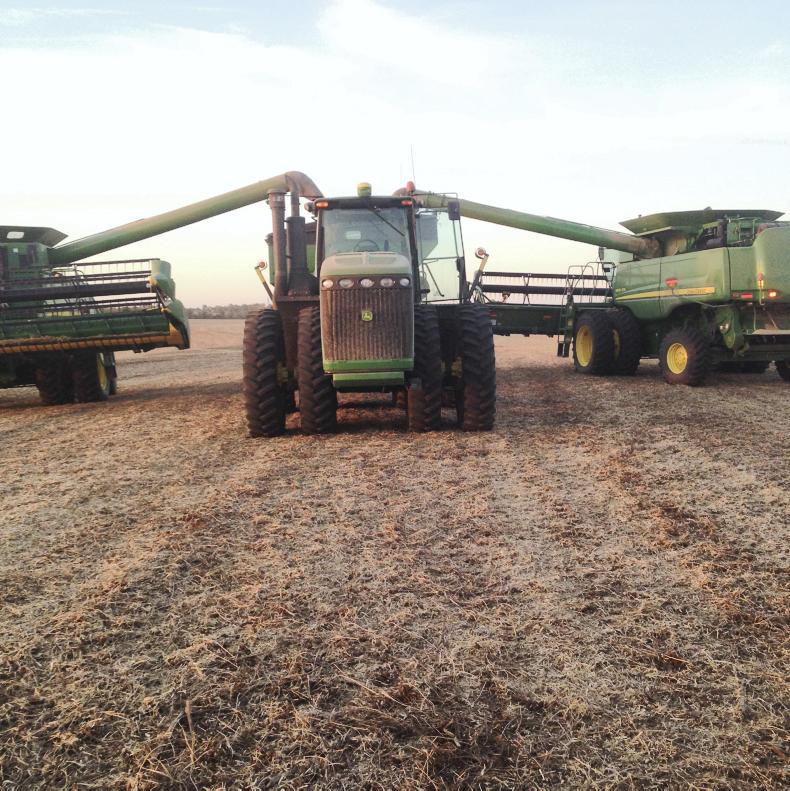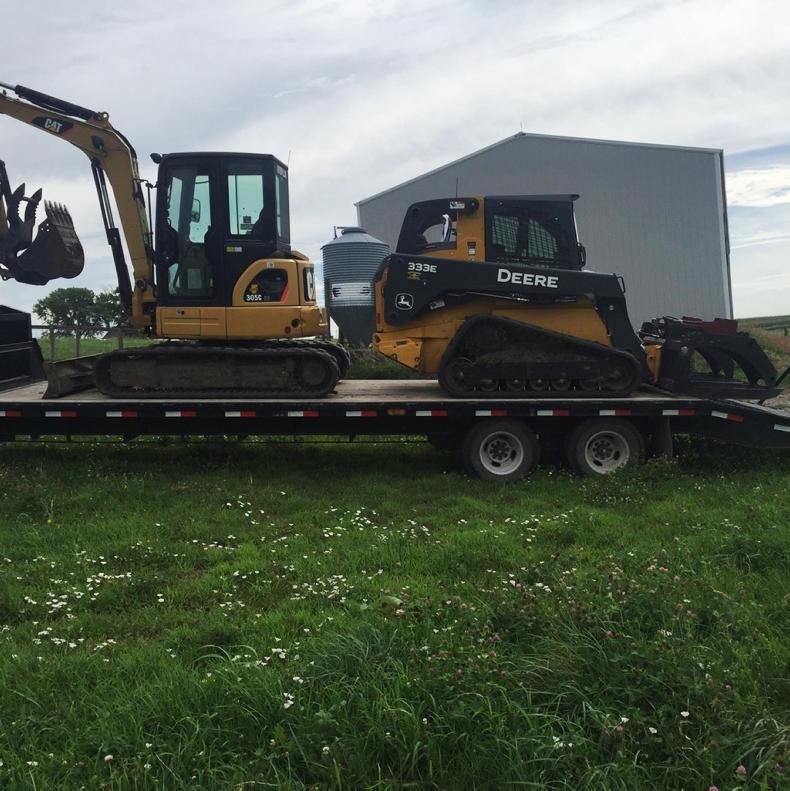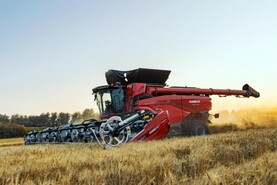Harvest 2016 started on the Rosenbohm Farm on 19 September. Corn, or maize, was the first to be cut and this involved two John Deere 9670 combines, a chaser bin and three semi-trucks, or articulated trucks and trailers.
The two combines averaged 20 acres per hour, 10 acres each, and they worked from 9am to 9pm most days, only stopping for lunch around midday. The chaser bin was used to keep both combines moving at all times. It is fitted with its own weight cells which enabled the operator to know when there was a truck load on board, whereby it made its way to the nearest truck to unload.
Harvesting soya beans
The soya bean harvest started on 25 September and the third combine was used for this crop. This combine was accompanied by two trucks, enabling beans and corn to be cut at the same time using all three combines.
However, after two weeks of corn harvesting one of those combines was changed over to harvest beans, leaving only one combine harvesting the corn while two harvested the beans. One week later again and all three combines were harvesting beans.
All of the beans on the farm are used for seed production, so each combine had to be fully cleaned down between each field, which slowed down the operation at times. The farm also has a seed -processing plant, with very many different varieties of seed being grown and processed for different companies.
On the farm there was one 400-acre field with 33 different varieties of soya beans in it, in plots ranging from six to 13 acres each. The harvesting operation required two truck drivers, six trucks, a cleaning crew and an unloading group. Most of the time, one truck could hold the produce of a plot.
The trucks were tagged with each variety for easier unloading etc. The cleaning crew involved one person along with the combine driver, a jeep, a trailer with a leaf blower and two air compressors. There was a combine to be cleaned every 20-30 minutes. This was a critical process and everything had to be cleaned, such as grain tank, header, etc.
Once a truck arrived in the seed plant it was weighed, sampled, recorded and unloaded using a belt conveyer with the beans being placed into boxes. This process required a belt operator, two forklift drivers, someone filling the box and someone keeping on top of the paperwork. The 400 acres of seed was harvested in two and a half days. These beans were foundation-grade beans, grown for seed to be supplied as high-quality seed for future production.
On most other days the seed beans that were harvested went straight to the bins in the seed plant. There are seven bins there for holding beans. Each bin was tagged with the variety name and each load was recorded as it came in. There were up to four different varieties coming in at the same time so paperwork and records were critical to keep varieties separate.
These beans were then moved into the plant where they were cleaned and processed at a rate of 13.6t/hour.
Once they were cleaned they were put into one of eight overhead bins where three to five people worked to bag the beans into 850kg bags. The seed bags were filled at a rate of 30 bags per hour.
The fact that the bagging-rate was faster than the cleaner meant that the cleaner was started earlier in the morning and operated later into the night than the baggers. The cleaner operator normally helped with the bagging also. All the bags of seed were then loaded on to a trailer and transferred to a warehouse for storage.
On 25 October, one combine went back to harvest the remainder of the beans and two days later a second combine went to help with the corn. This was mainly harvesting on wet land, which was not passable first time round. The beans are a higher priority once they are ready for harvest, as they are going for seed production.
Short harvest season
The corn harvest finished on 29 October and the bean harvest was finished the following day. This year has been one of the shortest harvesting seasons they have seen in a few years. There were only seven to 10 days where there was not a combine running in some crop. The stoppages were caused by rain and the damp weather.
We had a few breakdowns during harvest, but with three combines operating, production didn’t fall by much and the longest a combine was stopped for was 36 hours. This specific stoppage was due to a fire which burnt a wiring loom under the cab on one of the combines.
Gearbox bearings in the unloading augers went in two of the combines within a week of each other. These stoppages required a six-hour repair turnaround. There were also some problems with the turbo on the tractor pulling the chaser bin but this was repaired within an hour. All repairs, except for the wiring loom, were done by the Rosenbohms themselves.
The corn was harvested at moistures ranging from 14% to 18%, which made it easier to dry down to 15%. A lot of the corn came in under 15% and was put straight into the bin for storage, with air drawn through to get the temperature down. The aim is to have corn at under 3°C in the bin, which is very achievable due to the low night temperatures during winter.
The soya beans have to be harvested at between 11% and 14% for seed production. This always meant a later start in the morning and perhaps an earlier finish. This is because the beans are not dried, so they need to be taken in at low moisture levels to prevent sweating during storage, as this could affect germination capacity.
The average farm bean yield was 65 bu/ac (1.77 t/ac) and the corn was 176 bu/ac (4.5 t/ac).
Plans for the winter
While harvesting is now completed, there will still be lots of work to do in November and December. Seed beans will continue to come in from other farmers and these will need to be cleaned. All fields that were tracked by the combines will be disked, so that they are left level over winter.
Any areas of fields that were compacted due to weather conditions during harvest, or by the chaser bin and truck traffic, will be subsoiled. This will then enable the deep frosts to break up the soil over the winter.
New tile and drainage pipes will be laid in wet areas and terraces will be built. Any blocked pipes will be dug up and repaired and some surface damage due to wash-out will be repaired.
All bean stubbles will be sprayed with atrazine and the corn stubbles with be sprayed with metribuzin. These are both residual herbicides, which means they will work to keep the land weed-free right through to spring planting.
This was one of the shortest harvest seasons on Rosenbohm Farms for many years.Breakdowns and repairs are part of every harvest.Most corn crops were harvested under 15% moisture.Soya bean seed crops are all harvested below 14% moisture.
Harvest 2016 started on the Rosenbohm Farm on 19 September. Corn, or maize, was the first to be cut and this involved two John Deere 9670 combines, a chaser bin and three semi-trucks, or articulated trucks and trailers.
The two combines averaged 20 acres per hour, 10 acres each, and they worked from 9am to 9pm most days, only stopping for lunch around midday. The chaser bin was used to keep both combines moving at all times. It is fitted with its own weight cells which enabled the operator to know when there was a truck load on board, whereby it made its way to the nearest truck to unload.
Harvesting soya beans
The soya bean harvest started on 25 September and the third combine was used for this crop. This combine was accompanied by two trucks, enabling beans and corn to be cut at the same time using all three combines.
However, after two weeks of corn harvesting one of those combines was changed over to harvest beans, leaving only one combine harvesting the corn while two harvested the beans. One week later again and all three combines were harvesting beans.
All of the beans on the farm are used for seed production, so each combine had to be fully cleaned down between each field, which slowed down the operation at times. The farm also has a seed -processing plant, with very many different varieties of seed being grown and processed for different companies.
On the farm there was one 400-acre field with 33 different varieties of soya beans in it, in plots ranging from six to 13 acres each. The harvesting operation required two truck drivers, six trucks, a cleaning crew and an unloading group. Most of the time, one truck could hold the produce of a plot.
The trucks were tagged with each variety for easier unloading etc. The cleaning crew involved one person along with the combine driver, a jeep, a trailer with a leaf blower and two air compressors. There was a combine to be cleaned every 20-30 minutes. This was a critical process and everything had to be cleaned, such as grain tank, header, etc.
Once a truck arrived in the seed plant it was weighed, sampled, recorded and unloaded using a belt conveyer with the beans being placed into boxes. This process required a belt operator, two forklift drivers, someone filling the box and someone keeping on top of the paperwork. The 400 acres of seed was harvested in two and a half days. These beans were foundation-grade beans, grown for seed to be supplied as high-quality seed for future production.
On most other days the seed beans that were harvested went straight to the bins in the seed plant. There are seven bins there for holding beans. Each bin was tagged with the variety name and each load was recorded as it came in. There were up to four different varieties coming in at the same time so paperwork and records were critical to keep varieties separate.
These beans were then moved into the plant where they were cleaned and processed at a rate of 13.6t/hour.
Once they were cleaned they were put into one of eight overhead bins where three to five people worked to bag the beans into 850kg bags. The seed bags were filled at a rate of 30 bags per hour.
The fact that the bagging-rate was faster than the cleaner meant that the cleaner was started earlier in the morning and operated later into the night than the baggers. The cleaner operator normally helped with the bagging also. All the bags of seed were then loaded on to a trailer and transferred to a warehouse for storage.
On 25 October, one combine went back to harvest the remainder of the beans and two days later a second combine went to help with the corn. This was mainly harvesting on wet land, which was not passable first time round. The beans are a higher priority once they are ready for harvest, as they are going for seed production.
Short harvest season
The corn harvest finished on 29 October and the bean harvest was finished the following day. This year has been one of the shortest harvesting seasons they have seen in a few years. There were only seven to 10 days where there was not a combine running in some crop. The stoppages were caused by rain and the damp weather.
We had a few breakdowns during harvest, but with three combines operating, production didn’t fall by much and the longest a combine was stopped for was 36 hours. This specific stoppage was due to a fire which burnt a wiring loom under the cab on one of the combines.
Gearbox bearings in the unloading augers went in two of the combines within a week of each other. These stoppages required a six-hour repair turnaround. There were also some problems with the turbo on the tractor pulling the chaser bin but this was repaired within an hour. All repairs, except for the wiring loom, were done by the Rosenbohms themselves.
The corn was harvested at moistures ranging from 14% to 18%, which made it easier to dry down to 15%. A lot of the corn came in under 15% and was put straight into the bin for storage, with air drawn through to get the temperature down. The aim is to have corn at under 3°C in the bin, which is very achievable due to the low night temperatures during winter.
The soya beans have to be harvested at between 11% and 14% for seed production. This always meant a later start in the morning and perhaps an earlier finish. This is because the beans are not dried, so they need to be taken in at low moisture levels to prevent sweating during storage, as this could affect germination capacity.
The average farm bean yield was 65 bu/ac (1.77 t/ac) and the corn was 176 bu/ac (4.5 t/ac).
Plans for the winter
While harvesting is now completed, there will still be lots of work to do in November and December. Seed beans will continue to come in from other farmers and these will need to be cleaned. All fields that were tracked by the combines will be disked, so that they are left level over winter.
Any areas of fields that were compacted due to weather conditions during harvest, or by the chaser bin and truck traffic, will be subsoiled. This will then enable the deep frosts to break up the soil over the winter.
New tile and drainage pipes will be laid in wet areas and terraces will be built. Any blocked pipes will be dug up and repaired and some surface damage due to wash-out will be repaired.
All bean stubbles will be sprayed with atrazine and the corn stubbles with be sprayed with metribuzin. These are both residual herbicides, which means they will work to keep the land weed-free right through to spring planting.
This was one of the shortest harvest seasons on Rosenbohm Farms for many years.Breakdowns and repairs are part of every harvest.Most corn crops were harvested under 15% moisture.Soya bean seed crops are all harvested below 14% moisture. 





 This is a subscriber-only article
This is a subscriber-only article















SHARING OPTIONS: